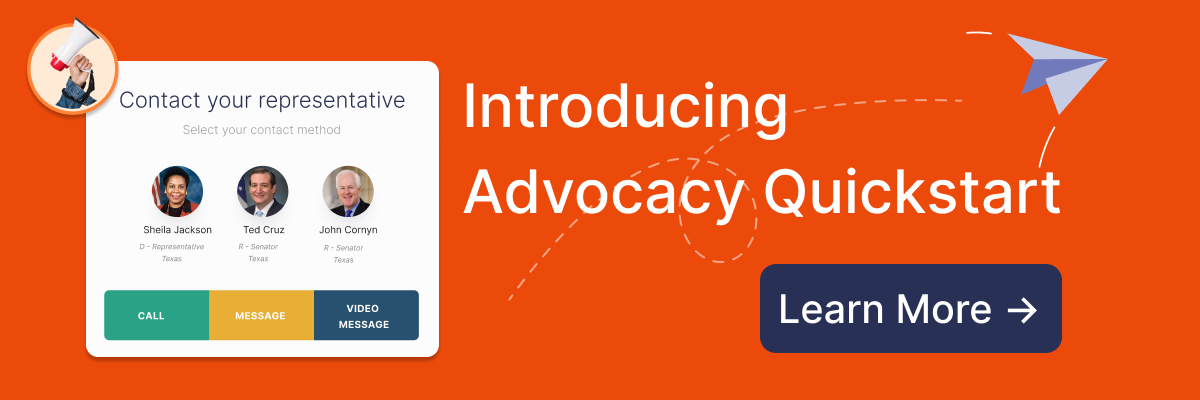What is Grassroots Lobbying?
Grassroots Lobbying Definition
Grassroots lobbying is a type of lobbying that aims to influence legislation by encouraging the public to contact legislators and government officials. Grassroots lobbying work is distinguished from direct lobbying, which involves directly communicating with legislators.
Grassroots lobbying often involves media outreach, social media, and mass mobilization of the public around a specific policy issue. The goal is to create a movement that puts pressure on legislators to listen to the concerns of their constituents.
Grassroots lobbying plays a crucial role in shaping public opinion and influencing legislation.
By mobilizing and engaging communities, grassroots lobbying brings attention and public awareness to important issues that may otherwise go unknown. Grassroots lobbying empowers citizens to participate in the political process and encourages them to take action by contacting legislators and government officials. Through the grassroots lobbying strategy, the general public's voices are heard, and their opinions are considered by policymakers, ensuring their interests are represented in the decision-making process.
The Difference Between Direct and Indirect Lobbying
Direct lobbying and its regulations
Direct lobbying involves a representative of an interest group directly communicating with legislators and government representatives to influence policies. Where grassroots lobbying is a one-to-many method of lobbying, direct lobbying is one-to-one.
Direct lobbying is subject to several regulations. The Lobbying Disclosure Act of 1995 requires all lobbying entities to register with the Secretary of the Senate and the Clerk of the House of Representatives. Failure to comply can result in penalties and fines.
Non-profit organizations can lobby under the Public Charity Lobbying Law, but there are restrictions on the amount of lobbying they can do before losing their non-profit status.
The Honest Leadership and Open Government Act places restrictions on gifts for Congress members and requires mandatory disclosure of earmarks in expenditure bills. Many states also have their own regulations on lobbying, NCSL provides a comprehensive list. Lobbying expenditures, including grassroots lobbying expenditures, must also be reported to the IRS.
While direct lobbying is an important tool for advocacy, organizations may also turn to indirect, or grassroots, lobbying to influence policies.
Indirect lobbying and how it involves the general public
Indirect lobbying, or grassroots lobbying, involves encouraging the general public to advocate for a specific policy position or issue.
This type of lobbying aims to build a groundswell of support that can influence legislators and government officials. Indirect lobbying can take many forms, including public rallies, media lobbying such as social media campaigns, email or letter-writing campaigns, and media outreach to a legislative body or government official.
By mobilizing the public and providing them with the tools and resources to contact their elected officials, grassroots lobbyists can build a broad base of support for their cause and increase their chances of influencing policy outcomes. Indirect lobbying is a powerful tool for advocacy that can help campaigns create change from the ground up.
How Grassroots Lobbying is Organized
Organizing Grassroots Lobbying Efforts: The Roles of 501(c)(3) Organizations, Businesses, and 501(c)(4) Advocacy Groups
Grassroots lobbying is typically organized by 501(c)(3) organizations, businesses, and 501(c)(4) advocacy groups. These groups may provide education and resources to their members or supporters, and encourage them to contact their elected officials to advocate for a specific policy position or issue.
501(c)(3) organizations, which include many nonprofits and charitable organizations, are able to engage in a limited amount of lobbying activities. These organizations may focus on educating their advocates or the public about key policy issues, and provide them with the tools and resources to contact their elected officials.
501(c)(4) advocacy groups, on the other hand, are specifically organized for lobbying and political activities. These groups can engage in more extensive lobbying activities, but must also adhere to certain disclosure and reporting requirements.
Businesses may also organize grassroots lobbying campaigns, particularly if they are impacted by specific policy issues or legislation. This may involve encouraging their employees or customers to contact their elected officials, or partnering with other organizations to build a coalition around a shared policy goal.
Overall, the success of grassroots lobbying activities often depends on the ability of these organizations to build a broad base of support and mobilize their members or supporters to take action. By providing education, resources, and advocacy tools, these organizations can help to amplify the voices of their constituents and attempt to influence legislation on key policy issues.
%20(Twitter%20Post)%20(LinkedIn%20Post)%20(LinkedIn%20Post)%20(1200%20%C3%97%20400%20px)%20(13).png?width=1000&height=300&name=Copy%20of%20Copy%20of%20Copy%20of%20Stat%20linkedin%20graphic%20(Twitter%20Post)%20(Twitter%20Post)%20(LinkedIn%20Post)%20(LinkedIn%20Post)%20(1200%20%C3%97%20400%20px)%20(13).png)
Grassroots Lobbying Campaign Techniques
Grassroots lobbying involves a variety of techniques aimed at mobilizing the public around a specific policy issue or position. These techniques include:
Education of constituents through press conferences, press releases, and published resources
Grassroots lobbyists often begin with an education campaign to inform constituents about the policy issue or position at hand. This may involve hosting press conferences, issuing press releases, or publishing resources such as fact sheets, reports, or position papers.
By providing information and context around a particular issue, organizations can help to build understanding and support among the general public.
Mobilizing segmented groups
Grassroots lobbying often involves mobilizing targeted individuals or groups to create a movement around a specific issue or position.
This may involve identifying key influencers, community leaders, or other individuals with a vested interest in the issue, and providing them with the resources and tools to become advocates for the cause.
By building a network of supporters who are invested in the issue, grassroots lobbyists can create a groundswell of support and increase their chances of influencing policy outcomes.
Use of media outlets, including social media and impact hubs to expand outreach
The use of media outlets, including social media, is a crucial component of grassroots lobbying work.
Social media platforms such as Twitter, Facebook, and Instagram can be used to share information and updates, promote events or rallies, and encourage followers to take action.
Other publishing outlets, such as impact hubs provide organizations with a way to share information and make people's voices heard in a controlled environment.
The success of grassroots lobbying depends on the ability of organizations to effectively educate, mobilize, and engage their supporters. By utilizing a variety of techniques and channels, an organization can build momentum around key policy issues and ensure that its voices are heard in the decision-making process.
%20(Twitter%20Post)%20(LinkedIn%20Post)%20(LinkedIn%20Post)%20(1200%20%C3%97%20400%20px)%20(16).png?width=1000&height=300&name=Copy%20of%20Copy%20of%20Copy%20of%20Stat%20linkedin%20graphic%20(Twitter%20Post)%20(Twitter%20Post)%20(LinkedIn%20Post)%20(LinkedIn%20Post)%20(1200%20%C3%97%20400%20px)%20(16).png)
Levels of Grassroots Lobbying
Grassroots lobbying can take place at different levels of government, including local, state, and federal. Each level presents different opportunities and challenges for grassroots lobbyists.
The examples of issues a campaign might attempt to influence at different levels of government:
Local
At the local level, a grassroots campaign may focus on issues such as zoning, land use, or public safety.
A local grassroots campaign may involve targeting city council members, mayors, or other local officials who have the power to influence local policy.
A grassroots campaign may also engage with local community groups, neighborhood associations, or other stakeholders to build support and mobilize constituents around important issues.
State
Grassroots lobbying at the state level may focus on a broader range of policy issues, such as education, healthcare, or environmental regulation, as well as other specific legislation.
This may involve targeting lawmakers in the state legislature, governors, or other state officials who have the power to influence specific legislation.
An organization may also work with state-level advocacy groups, professional associations, or other stakeholders to build coalitions and amplify its message.
Federal
A grassroots lobbying campaign at the federal level may focus on national policy issues, such as healthcare reform, climate change, or immigration.
This may involve targeting a member of the federal legislative body, the executive branch, or a government official who can affect federal policy such as the head of the FTC.
Organizations may also engage with national advocacy groups, industry associations, or other stakeholders to build alliances and increase their impact on important issues.
Overall, the level of grassroots lobbying effort will depend on the specific policy issue or position being advocated for, as well as the stakeholders who have the power to influence policy at each level of government.
By carefully targeting their advocacy efforts and building coalitions with other stakeholders, grassroots lobbying efforts can maximize their impact and help to shape policy outcomes at all levels of government.
Tools Grassroots Lobbyists Use
Grassroots lobbying relies on a variety of tools to engage and mobilize supporters. Some of the most effective tools used in grassroots lobbying include:
Calling, video, email, and lawmaker outreach
One of the most important tools for grassroots lobbying is direct communication with lawmakers and other officials. This can take many forms, including phone calls, emails, or video messages. Organizations may use software tools like Countable, which enables them to quickly and easily connect with policymakers at the local, state, and federal levels. With Countable, advocates can create personalized messages and reach out to lawmakers en masse, helping to amplify their message and increase their impact.
Legislative tracking
Grassroots lobbying efforts also rely on the ability to track legislation and stay up-to-date on policy developments on capitol hill.
This can involve monitoring bills as they move through the legislative process, tracking the voting records of a legislator, or analyzing regulatory proposals.
By staying informed and engaged with the policymaking process, grassroots lobbying efforts can effectively target their advocacy efforts and shape policy outcomes.
Conclusion
Grassroots lobbying is a powerful tool for shaping and influencing policy outcomes, from local to federal law to more general policy. By mobilizing communities and engaging with policymakers at all levels of government, grassroots lobbying efforts can help to ensure that the voices of the people are heard and their interests are represented in the decision-making process.
To be effective, grassroots lobbying efforts must be well-organized and focused on building coalitions with other stakeholders. This involves using a variety of tools and techniques, including direct communication with lawmakers, legislative tracking, and targeted outreach to key constituencies.
As technology continues to evolve, grassroots lobbying efforts will only become more important in shaping public opinion and influencing policy outcomes. By staying engaged and active in the political process, individuals and organizations can help to ensure that their voices are heard and that their interests are represented in the policymaking process.
Share this
You May Also Like
These Related Stories

4 Examples of Successful Digital Advocacy Campaigns
.jpg?width=727&height=480&name=iStock-1385509455%20(1).jpg)
Key Takeaways from the Public Affairs Council Advocacy Conference


%20(Twitter%20Post)%20(LinkedIn%20Post)%20(LinkedIn%20Post)%20(1200%20%C3%97%20400%20px)%20(10).png?width=1000&height=300&name=Copy%20of%20Copy%20of%20Copy%20of%20Stat%20linkedin%20graphic%20(Twitter%20Post)%20(Twitter%20Post)%20(LinkedIn%20Post)%20(LinkedIn%20Post)%20(1200%20%C3%97%20400%20px)%20(10).png)
%20(Twitter%20Post)%20(LinkedIn%20Post)%20(LinkedIn%20Post)%20(1200%20%C3%97%20400%20px)%20(11)-1.png?width=1000&height=300&name=Copy%20of%20Copy%20of%20Copy%20of%20Stat%20linkedin%20graphic%20(Twitter%20Post)%20(Twitter%20Post)%20(LinkedIn%20Post)%20(LinkedIn%20Post)%20(1200%20%C3%97%20400%20px)%20(11)-1.png)
%20(Twitter%20Post)%20(LinkedIn%20Post)%20(LinkedIn%20Post)%20(1200%20%C3%97%20400%20px)%20(12)-1.png?width=1000&height=300&name=Copy%20of%20Copy%20of%20Copy%20of%20Stat%20linkedin%20graphic%20(Twitter%20Post)%20(Twitter%20Post)%20(LinkedIn%20Post)%20(LinkedIn%20Post)%20(1200%20%C3%97%20400%20px)%20(12)-1.png)

%20(Twitter%20Post)%20(LinkedIn%20Post)%20(LinkedIn%20Post)%20(1200%20%C3%97%20400%20px)%20(15)-1.png?width=1000&height=300&name=Copy%20of%20Copy%20of%20Copy%20of%20Stat%20linkedin%20graphic%20(Twitter%20Post)%20(Twitter%20Post)%20(LinkedIn%20Post)%20(LinkedIn%20Post)%20(1200%20%C3%97%20400%20px)%20(15)-1.png)
%20(Twitter%20Post)%20(LinkedIn%20Post)%20(LinkedIn%20Post)%20(1200%20%C3%97%20400%20px)-3.png?width=1000&height=300&name=Copy%20of%20Copy%20of%20Copy%20of%20Stat%20linkedin%20graphic%20(Twitter%20Post)%20(Twitter%20Post)%20(LinkedIn%20Post)%20(LinkedIn%20Post)%20(1200%20%C3%97%20400%20px)-3.png)